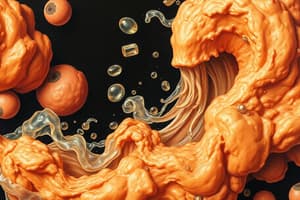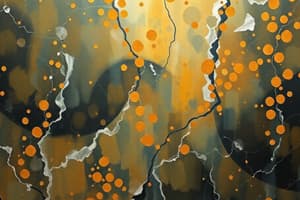Podcast
Questions and Answers
Proteins are made up of the elements C, H, O, and N in no set ______
Proteins are made up of the elements C, H, O, and N in no set ______
ratio
The amino acids bind together with a ______ bond
The amino acids bind together with a ______ bond
peptide
Amino acids bond together via ______ synthesis
Amino acids bond together via ______ synthesis
dehydration
When two amino acids form the beginning of the chain with one peptide bond, it is called a ______
When two amino acids form the beginning of the chain with one peptide bond, it is called a ______
Ultimately you end up with a ______ (which can have anywhere between 30 and 30,000 amino acids)
Ultimately you end up with a ______ (which can have anywhere between 30 and 30,000 amino acids)
Primary structure involves the ________ of amino acids
Primary structure involves the ________ of amino acids
_______ structure is formed by twisting and folding the primary structure
_______ structure is formed by twisting and folding the primary structure
Tertiary structure is the ________ shape of a protein
Tertiary structure is the ________ shape of a protein
_______ structure involves 2 or more chains joined together
_______ structure involves 2 or more chains joined together
Denaturation can occur due to high ________ affecting weak hydrogen bonds
Denaturation can occur due to high ________ affecting weak hydrogen bonds
Flashcards are hidden until you start studying
Study Notes
Composition of Proteins
- Proteins are composed of the elements carbon, hydrogen, oxygen, and nitrogen (in no set ratio)
Structure of Amino Acids
- Amino acids are the building blocks of proteins
- Amino acids have three parts:
- Amino group (NH2 or NH3+), which acts as a base
- Carboxyl group (COOH or COO-), which acts as an acid
- R group (there are 20 different possible R groups)
Formation of Proteins
- Amino acids bond together via dehydration synthesis
- Peptide bonds are formed between carbon and nitrogen atoms, with one water molecule lost
- When two amino acids form the beginning of a chain (with one peptide bond), it is called a dipeptide
- The chain grows to become a tripeptide and eventually a polypeptide
- A polypeptide is also known as a protein
Characteristics of Proteins
- Every protein is different due to the unique order of amino acids
- The order of amino acids affects the chain's structure and function
Levels of Protein Structure
- Primary structure: the order of amino acids joined together with peptide bonds
- Secondary structure: twisting and folding of the primary structure, forming hydrogen bonds
- Tertiary structure: interactions between R groups, determining the protein's 3D shape and function
- Quaternary structure: two or more chains joined to form a functional protein
Denaturation
- Denaturation is the loss of a protein's tertiary or quaternary structure, affecting its function
- Denaturation can occur due to:
- High temperatures, affecting hydrogen bonds
- Chemicals, such as heavy metals or acid/basic substances
- Structural changes
Functions of Proteins
- Structural: proteins make up all structures in living things (e.g., keratin, actin, myosin, collagen)
- Functional: proteins help maintain bodily functions and digest food (e.g., hemoglobin, enzymes)
- Food source: proteins provide energy when carbohydrates and fats are depleted
Studying That Suits You
Use AI to generate personalized quizzes and flashcards to suit your learning preferences.




